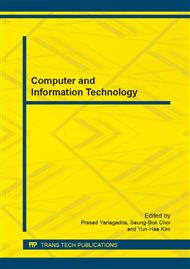p.66
p.70
p.77
p.85
p.90
p.98
p.102
p.108
p.117
Research on Parallel Yen Algorithms on GPUs Using CUDA
Abstract:
With the arrival of the intermodality era, to design fast and efficient K shortest paths (KSP) algorithms becomes gradually one of the core technologies in traveler information systems. Yen is a classical algorithm for KSP. However, Yen is time-consuming. In view of powerful general-purpose computing capabilities, GPU(Graphics Processing Units) has received increasing attention in various fields. Based on CUDA software development environment, combined with the structure of the Yen algorithm itself, this paper proposed two parallel algorithms for Yen. The first parallel algorithm computes candidate shortest paths for very possible deviation nodes in parallel. The second one computes candidate shortest paths in serial, but computes very candidate path in parallel. Finally, the efficiency of the two parallel algorithms was tested through experiments.
Info:
Periodical:
Pages:
90-97
Citation:
Online since:
February 2014
Authors:
Price:
Сopyright:
© 2014 Trans Tech Publications Ltd. All Rights Reserved
Share:
Citation:


